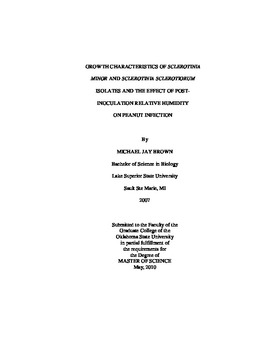| dc.contributor.advisor | Melouk, Hassan | |
| dc.contributor.author | Brown, Michael Jay | |
| dc.date.accessioned | 2014-04-15T21:16:42Z | |
| dc.date.available | 2014-04-15T21:16:42Z | |
| dc.date.issued | 2010-05-01 | |
| dc.identifier.uri | https://hdl.handle.net/11244/8987 | |
| dc.description.abstract | Sclerotinia blight is the most costly soilborne disease of peanut in Oklahoma, affecting yield and quality. Though the disease can be caused by both Sclerotinia minor and S. sclerotiorum, S. minor is the predominant species causing disease in the United States. This study was designed to compare the two species through: 1) Hyphal growth rates, sclerotial production, and sclerotial viability on SPDA culture medium. 2) Rate of lesion expansion (RLE), area under disease progress curve values (AUDPC), sclerotial production, and sclerotial viability on seedlings of peanut cultivars with different levels of Sclerotinia resistance. 3) AUDPC values and percent infection when shortening the period of high relative humidity (RH) post-inoculation on seedlings of peanut cultivars with different levels of Sclerotiniaresistance. In the culture medium experiment, the two S. sclerotiorum isolates had the highest rates of hyphal growth, while S. minor produced the greatest number of sclerotia and the greatest sclerotial weight per plate. This confers an advantage to S. minor because each sclerotium, regardless of size, constitutes and infection propagule. For the peanut inoculations, results were similar when using both the RLE and AUPDC methods, indicating that either method is appropriate for comparing lesion expansion on peanut. The results suggest that the S. sclerotiorum isolate from pumpkin was the most aggressive, with the S. minor isolate being intermediately aggressive, and the S. sclerotiorum isolate from peanut being only lowly aggressive. Neither method was consistently able to show statistical differences in lesion expansion between the two peanut cultivars. S. minor again produced significantly more sclerotia compared to theS. sclerotiorum isolates. For the shortened humidity experiments, the data seem to indicate that while a minimum of 1 day of high RH was required for successful infection, 2 days is required to get 100% infection. AUDPC values generally increased as humidity treatment length increased, but tended to stabilize beyond 2 days of high humidity. Sclerotia were not produced on any plants subject to less than 7 days of high relative humidity | |
| dc.format | application/pdf | |
| dc.language | en_US | |
| dc.publisher | Oklahoma State University | |
| dc.rights | Copyright is held by the author who has granted the Oklahoma State University Library the non-exclusive right to share this material in its institutional repository. Contact Digital Library Services at lib-dls@okstate.edu or 405-744-9161 for the permission policy on the use, reproduction or distribution of this material. | |
| dc.title | Growth Characteristics of Sclerotinia Minor and Sclerotinia scerotiorum Isolates and the Effect of Post-Inoculation Relative Humidity on Peanut Infection | |
| dc.type | text | |
| dc.contributor.committeeMember | Hunger, Robert | |
| dc.contributor.committeeMember | Payton, Mark | |
| osu.filename | Brown_okstate_0664M_10785.pdf | |
| osu.college | Agricultural Sciences and Natural Resources | |
| osu.accesstype | Open Access | |
| dc.description.department | Department of Entomology and Plant Pathology | |
| dc.type.genre | Thesis | |
